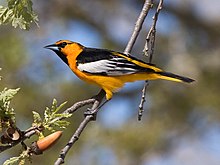Icterids
| Icterids | |
|---|---|
 |
|
| Adult male Bullock's oriole | |
| Scientific classification | |
| Kingdom: | Animalia |
| Phylum: | Chordata |
| Class: | Aves |
| Order: | Passeriformes |
| Suborder: | Passeri |
| Family: |
Icteridae Vigors, 1825 |
| Genera | |
|
29, See text |
|
29, See text
Icterids make up a family (Icteridae) of small- to medium-sized, often colorful, New-World passerine birds. Most species have black as a predominant plumage color, often enlivened by yellow, orange or red. The family varies widely in size, shape, behavior and coloration. The name, meaning "jaundiced ones" (from the prominent yellow feathers of many species) comes from the Ancient Greek ikteros via the Latin ictericus. This group includes the New World blackbirds, New World orioles, the bobolink, meadowlarks, grackles, cowbirds, oropendolas and caciques.
Despite the similar names, the first groups are only distantly related to the Old World common blackbird (a thrush) or the Old World orioles.
Icteridae is not to be confused with Icteriidae, a newly created family consisting of one species (the Yellow-Breasted Chat). Although the names are similar, the two families are not closely related.
The majority of icterid species live in the tropics, although there are a number of temperate forms, such as American blackbirds and the long-tailed meadowlark. The highest densities of breeding species are found in Colombia and in southern Mexico. They inhabit a range of habitats, including scrub, swamp, forest, and savanna. Temperate species are migratory, with many species that nest in the United States and Canada moving south into Mexico and Central America.
...
Wikipedia
